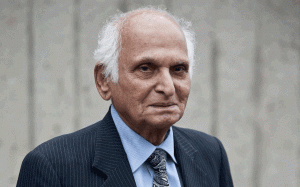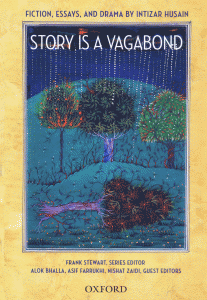Book Review: Story is a Vagabond
By Nusrat Khawaja | Bookmark | Published 9 years ago
Intizar Husain’s death in February this year brought to an end one of the most syncretic voices in the canon of Urdu literature. Husain was born in the tehsil town of Dibai in Uttar Pradesh in 1923 and moved to Lahore soon after Partition. The vernacular Urdu of his hometown always remained a part of his idiom.
This iconic writer’s oeuvre covered fiction (including numerous short stories and five novels), essays and regular columns to newspapers. His novel Basti was translated into English by Frances Pritchett in 1995. This gave his work access to international readership and Basti was shortlisted for the Man Booker International Prize in 2013.
An anthology is a fitting tribute to a writer with such a diverse portfolio. Oxford University Press, Pakistan, has recently published one with the title Story is a Vagabond. It contains short stories, a play, some essays and a conversation with one of the editors and translators — Alok Bhalla — in which we learn rather more about Bhalla than about Intizar Hussain.
The dust jacket of the book features the miniature painting ‘Rise and Fall’ (2014) by the Pakistani artist, Imran Qureshi. This is the only painting which is printed in colour. There are other paintings by Qureshi randomly distributed within the text but these are disappointingly printed in black-and-white.
Qureshi’s beautiful and unsettling landscape with trees is an appropriate choice to showcase this anthology of a writer whose work is never far from communion with landscapes borne of myth and memory.
 Intizar Husain embraced the diverse storytelling traditions of the Indian subcontinent. He understood that the bedrock of a civilisation lay in myth which stores and refuels cultural modes of behaviour from its subterranean chambers of compressed memory. He understood that wilderness was tamed through the medium of legend. Chaos had to form into order through the medium of a story in order for a community to exist and cities to arise. In the essay ‘Vanishing Tradition,’ Intizar Husain wrote: “A traditional city is rarely a purely man-made phenomenon. It might well have been founded by a Raja or a Nawab, but some legend elevates it to a plane where, developing an association with something unearthly, it seems to touch the mysterious borders of the unknown.”
Intizar Husain embraced the diverse storytelling traditions of the Indian subcontinent. He understood that the bedrock of a civilisation lay in myth which stores and refuels cultural modes of behaviour from its subterranean chambers of compressed memory. He understood that wilderness was tamed through the medium of legend. Chaos had to form into order through the medium of a story in order for a community to exist and cities to arise. In the essay ‘Vanishing Tradition,’ Intizar Husain wrote: “A traditional city is rarely a purely man-made phenomenon. It might well have been founded by a Raja or a Nawab, but some legend elevates it to a plane where, developing an association with something unearthly, it seems to touch the mysterious borders of the unknown.”
The unearthly manifested itself in the shape of a tree or a shrine or an animal. In ‘A Chronicle of the Peacocks,’ the peacock becomes a symbol of the connection between the past and the present, a gateway to access what otherwise lies forgotten: “I had reached Saravasthi late in the afternoon. Mahatma Buddha had lived there a long time ago. The vihara where he used to stay with his monks during the monsoon was now in ruins…The peacock on the hill was, perhaps, the last of the survivors from the days of the Buddha, and still carried images of those days in his eyes.”
Continuity of cultural transmission through sacred texts mattered profoundly to Intizar Husain. The retelling of time-honored tales was a talisman against loss of cultural enhancements. The Jatakas relating to the Buddha’s previous rebirths, the Ramayana and the Mahabharata, the Epic of Gilgamesh all became part of his eclectic repertoire.
The grand mythic and folkloric story cycles are reiterated by Intizar Husain’s maintained relevance with the past. With continuities, however, there was also disruption. The greatest disruption in Intizar Husain’s life came in the tumultuous shape of the partition of India. The severance from a homeland and the perpetual nostalgia induced by separations became elements for recalling vignettes from mohalla life as in `Qayyuma’s Shop’ and `Toward His Fire.’
Intizar Husain’s spectrum of stories could range from the traditional to highly postmodern, particularly when he examined the fragmentation of the psyche. In ‘The Lost Ones,’ a discussion on the disorientation of a wounded man becomes a quest for self-validation that is permeated with irony. The man says to his companions: “Since you bear witness to my being,” he sighed, “therefore I am. And what a pity! I exist because others think I do.”
In the stories collected within the anthology, women do not feature significantly. They are mentioned as seductresses as in `Complete Knowledge’ or as passive objects of desire as in `A Stranded Railroad Car.’ In `A Conversation with Intizar Husain,’ however, the writer expresses his admiration for the strong women who have emerged against the growing tide of conservatism in Pakistan, women such as Malala Yusufzai and Mukhtaran Mai who ask for justice and equality.
In the same conversation with Alok Bhalla, Intizar Husain made the pithy comment on the nature of a story: “Kahani to awara hoti hai [a story is footloose].” It is from this comment that the editors have derived the title of the book. But here a quibble must be made. Surely in translating Intizar Husain’s comment, the article `A’ needed to be added in order for the writer’s comment to translate correctly into English as ‘A Story is a Vagabond’?
One would like to give the editors an A for compiling a competent anthology except that they have done away with it themselves.



